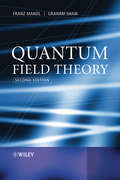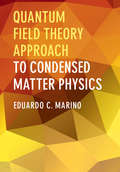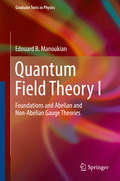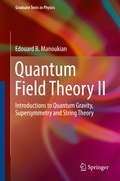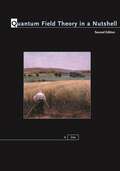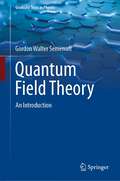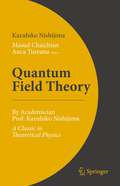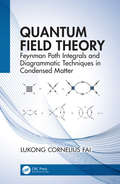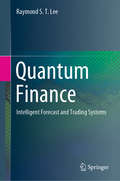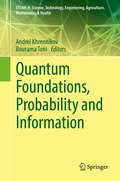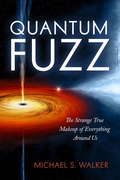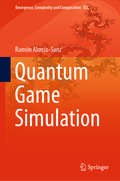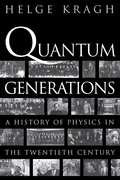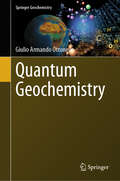- Table View
- List View
Quantum Field Theory
by Graham Shaw Franz MandlFollowing on from the successful first (1984) and revised (1993) editions, this extended and revised text is designed as a short and simple introduction to quantum field theory for final year physics students and for postgraduate students beginning research in theoretical and experimental particle physics.The three main objectives of the book are to:Explain the basic physics and formalism of quantum field theoryTo make the reader proficient in theory calculations using Feynman diagramsTo introduce the reader to gauge theories, which play a central role in elementary particle physics.Thus, the first ten chapters deal with QED in the canonical formalism, and are little changed from the first edition. A brief introduction to gauge theories (Chapter 11) is then followed by two sections, which may be read independently of each other. They cover QCD and related topics (Chapters 12-15) and the unified electroweak theory (Chapters 16 - 19) respectively. Problems are provided at the end of each chapter.New to this edition:Five new chapters, giving an introduction to quantum chromodynamics and the methods used to understand it: in particular, path integrals and the renormalization group.The treatment of electroweak interactions has been revised and updated to take account of more recent experiments.
Quantum Field Theory
by Lewis H. RyderThis book is a modern pedagogic introduction to the ideas and techniques of quantum field theory. After a brief overview of particle physics and a survey of relativistic wave equations and Lagrangian methods, the quantum theory of scalar and spinor fields, and then of gauge fields, is developed. The emphasis throughout is on functional methods, which have played a large part in modern field theory. The book concludes with a brief survey of 'topological' objects in field theory and, new to this edition, a chapter devoted to supersymmetry.
Quantum Field Theory
by Mark SrednickiTextbook on elementary particles for graduate students studying quantum field theory and elementary particle theory.
Quantum Field Theory Approach To Condensed Matter Physics
by Eduardo C. MarinoA balanced combination of introductory and advanced topics provides a new and unique perspective on the quantum field theory approach to condensed matter physics. Beginning with the basics of these subjects, such as static and vibrating lattices, independent and interacting electrons, the functional formulation for fields and different generating functionals and their roles, this book presents a unified viewpoint illustrating the connections and relationships among various physical concepts and mechanisms. Advanced and newer topics bring the book up to date with current developments and include sections on cuprate and pnictide superconductors, graphene, Weyl semimetals, transition metal dichalcogenides and topological insulators. Finally, well-known subjects such as the quantum Hall effect, superconductivity, Mott and Anderson insulators, and the Anderson-Higgs mechanism are examined within a unifying QFT-CMP approach. Presenting new insights on traditional topics, this text allows graduate students and researchers to master the proper theoretical tools required in a variety of condensed matter physics systems.
Quantum Field Theory I
by Edouard B. ManoukianThis textbook covers a broad spectrum of developments in QFT, emphasizing those aspects that are now well consolidated and for which satisfactory theoretical descriptions have been provided. The book is unique in that it offers a new approach to the subject and explores many topics merely touched upon, if covered at all, in standard reference works. A detailed and largely non-technical introductory chapter traces the development of QFT from its inception in 1926. The elegant functional differential approach put forward by Schwinger, referred to as the quantum dynamical (action) principle, and its underlying theory are used systematically in order to generate the so-called vacuum-to-vacuum transition amplitude of both abelian and non-abelian gauge theories, in addition to Feynman's well-known functional integral approach, referred to as the path-integral approach. Given the wealth of information also to be found in the abelian case, equal importance is put on both abelian and non-abelian gauge theories. Particular emphasis is placed on the concept of a quantum field and its particle content to provide an appropriate description of physical processes at high energies, where relativity becomes indispensable. Moreover, quantum mechanics implies that a wave function renormalization arises in the QFT field independent of any perturbation theory - a point not sufficiently emphasized in the literature. The book provides an overview of all the fields encountered in present high-energy physics, together with the details of the underlying derivations. Further, it presents "deep inelastic" experiments as a fundamental application of quantum chromodynamics. Though the author makes a point of deriving points in detail, the book still requires good background knowledge of quantum mechanics, including the Dirac Theory, as well as elements of the Klein-Gordon equation. The present volume sets the language, the notation and provides additional background for reading Quantum Field Theory II - Introduction to Quantum Gravity, Supersymmetry and String Theory, by the same author. Students in this field might benefit from first reading the book Quantum Theory: A Wide Spectrum (Springer, 2006), by the same author.
Quantum Field Theory II
by Edouard B. ManoukianThis book takes a pedagogical approach to explaining quantum gravity, supersymmetry and string theory in a coherent way. It is aimed at graduate students and researchers in quantum field theory and high-energy physics. The first part of the book introduces quantum gravity, without requiring previous knowledge of general relativity (GR). The necessary geometrical aspects are derived afresh leading to explicit general Lagrangians for gravity, including that of general relativity. The quantum aspect of gravitation, as described by the graviton, is introduced and perturbative quantum GR is discussed. The Schwinger-DeWitt formalism is developed to compute the one-loop contribution to the theory and renormalizability aspects of the perturbative theory are also discussed. This follows by introducing only the very basics of a non-perturbative, background-independent, formulation of quantum gravity, referred to as "loop quantum gravity", which gives rise to a quantization of space. In the second part the author introduces supersymmetry and its consequences. The generation of superfields is represented in detail. Supersymmetric generalizations of Maxwell's Theory as well as of Yang-Mills field theory, and of the standard model are worked out. Spontaneous symmetry breaking, improvement of the divergence problem in supersymmetric field theory, and its role in the hierarchy problem are covered. The unification of the fundamental constants in a supersymmetric version of the standard model are then studied. Geometrical aspects necessary to study supergravity are developed culminating in the derivation of its full action. The third part introduces string theory and the analysis of the spectra of the mass (squared) operator associated with the oscillating strings. The properties of the underlying fields, associated with massless particles, encountered in string theory are studied in some detail. Elements of compactification, duality and D-branes are given, as well of the generation of vertices and interactions of strings. In the final sections, the author shows how to recover GR and the Yang-Mills field Theory from string theory.
Quantum Field Theory Of Point Particles And Strings
by Brian HatfieldThe purpose of this book is to introduce string theory without assuming any background in quantum field theory. Part I of this book follows the development of quantum field theory for point particles, while Part II introduces strings. All of the tools and concepts that are needed to quantize strings are developed first for point particles. Thus, Part I presents the main framework of quantum field theory and provides for a coherent development of the generalization and application of quantum field theory for point particles to strings. Part II emphasizes the quantization of the bosonic string. The treatment is most detailed in the path integral representation where the object of interest, the partition function, is a sum over random surfaces. The relevant mathematics of Riemann surfaces is covered. Superstrings are briefly introduced, and the sum over genus 0 supersurfaces is computed. The emphasis of the book is calculational, and most computations are presented in step-by-step detail. The book is unique in that it develops all three representations of quantum field theory (operator, functional Schrödinger, and path integral) for point particles and strings. In many cases, identical results are worked out in each representation to emphasize the representation-independent structures of quantum field theory.
Quantum Field Theory Of Point Particles And Strings
by Brian HatfieldThe purpose of this book is to introduce string theory without assuming any background in quantum field theory. Part I of this book follows the development of quantum field theory for point particles, while Part II introduces strings. All of the tools and concepts that are needed to quantize strings are developed first for point particles. Thus, Part I presents the main framework of quantum field theory and provides for a coherent development of the generalization and application of quantum field theory for point particles to strings.Part II emphasizes the quantization of the bosonic string. The treatment is most detailed in the path integral representation where the object of interest, the partition function, is a sum over random surfaces. The relevant mathematics of Riemann surfaces is covered. Superstrings are briefly introduced, and the sum over genus 0 supersurfaces is computed.The emphasis of the book is calculational, and most computations are presented in step-by-step detail. The book is unique in that it develops all three representations of quantum field theory (operator, functional Schrödinger, and path integral) for point particles and strings. In many cases, identical results are worked out in each representation to emphasize the representation-independent structures of quantum field theory.
Quantum Field Theory Of Point Particles And Strings
by Brian HatfieldThe purpose of this book is to introduce string theory without assuming any background in quantum field theory. Part I of this book follows the development of quantum field theory for point particles, while Part II introduces strings. All of the tools and concepts that are needed to quantize strings are developed first for point particles. Thus, Part I presents the main framework of quantum field theory and provides for a coherent development of the generalization and application of quantum field theory for point particles to strings. Part II emphasizes the quantization of the bosonic string. The treatment is most detailed in the path integral representation where the object of interest, the partition function, is a sum over random surfaces. The relevant mathematics of Riemann surfaces is covered. Superstrings are briefly introduced, and the sum over genus 0 supersurfaces is computed. The emphasis of the book is calculational, and most computations are presented in step-by-step detail. The book is unique in that it develops all three representations of quantum field theory (operator, functional Schrödinger, and path integral) for point particles and strings. In many cases, identical results are worked out in each representation to emphasize the representation-independent structures of quantum field theory.
Quantum Field Theory Of Point Particles And Strings
by Brian HatfieldThe purpose of this book is to introduce string theory without assuming any background in quantum field theory. Part I of this book follows the development of quantum field theory for point particles, while Part II introduces strings. All of the tools and concepts that are needed to quantize strings are developed first for point particles. Thus, Part I presents the main framework of quantum field theory and provides for a coherent development of the generalization and application of quantum field theory for point particles to strings.Part II emphasizes the quantization of the bosonic string. The treatment is most detailed in the path integral representation where the object of interest, the partition function, is a sum over random surfaces. The relevant mathematics of Riemann surfaces is covered. Superstrings are briefly introduced, and the sum over genus 0 supersurfaces is computed.The emphasis of the book is calculational, and most computations are presented in step-by-step detail. The book is unique in that it develops all three representations of quantum field theory (operator, functional Schrödinger, and path integral) for point particles and strings. In many cases, identical results are worked out in each representation to emphasize the representation-independent structures of quantum field theory.
Quantum Field Theory Of Point Particles And Strings (Frontiers In Physics Ser.)
by Brian HatfieldFirst Published in 2018. Routledge is an imprint of Taylor & Francis, an Informa company.
Quantum Field Theory in Condensed Matter Physics
by Alexei M. TsvelikThis book is a course in modern quantum field theory as seen through the eyes of a theorist working in condensed matter physics. It contains a gentle introduction to the subject and therefore can be used even by graduate students. The introductory parts include a derivation of the path integral representation, Feynman diagrams and elements of the theory of metals including a discussion of Landau–Fermi liquid theory. In later chapters the discussion gradually turns to more advanced methods used in the theory of strongly correlated systems. The book contains a thorough exposition of such non-perturbative techniques as 1/N-expansion, bosonization (Abelian and non-Abelian), conformal field theory and theory of integrable systems. The book is intended for graduate students, postdoctoral associates and independent researchers working in condensed matter physics.
Quantum Field Theory in Curved Spacetime
by Leonard E. Parker David J. TomsIn this book, Robert Wald provides a coherent, pedagogical introduction to the formulation of quantum field theory in curved spacetime. He begins with a treatment of the ordinary one-dimensional quantum harmonic oscillator, progresses through the construction of quantum field theory in flat spacetime to possible constructions of quantum field theory in curved spacetime, and, ultimately, to an algebraic formulation of the theory. In his presentation, Wald disentangles essential features of the theory from inessential ones (such as a particle interpretation) and clarifies relationships between various approaches to the formulation of the theory. He also provides a comprehensive, up-to-date account of the Unruh effect, the Hawking effect, and some of its ramifications. In particular, the subject of black hole thermodynamics, which remains an active area of research, is treated in depth.
Quantum Field Theory in a Nutshell: Second Edition (In a Nutshell #7)
by Anthony ZeeA fully updated edition of the classic text by acclaimed physicist A. ZeeSince it was first published, Quantum Field Theory in a Nutshell has quickly established itself as the most accessible and comprehensive introduction to this profound and deeply fascinating area of theoretical physics. Now in this fully revised and expanded edition, A. Zee covers the latest advances while providing a solid conceptual foundation for students to build on, making this the most up-to-date and modern textbook on quantum field theory available.This expanded edition features several additional chapters, as well as an entirely new section describing recent developments in quantum field theory such as gravitational waves, the helicity spinor formalism, on-shell gluon scattering, recursion relations for amplitudes with complex momenta, and the hidden connection between Yang-Mills theory and Einstein gravity. Zee also provides added exercises, explanations, and examples, as well as detailed appendices, solutions to selected exercises, and suggestions for further reading.The most accessible and comprehensive introductory textbook availableFeatures a fully revised, updated, and expanded textCovers the latest exciting advances in the fieldIncludes new exercisesOffers a one-of-a-kind resource for students and researchers Leading universities that have adopted this book include:Arizona State UniversityBoston UniversityBrandeis UniversityBrown UniversityCalifornia Institute of TechnologyCarnegie MellonCollege of William & MaryCornellHarvard UniversityMassachusetts Institute of TechnologyNorthwestern UniversityOhio State UniversityPrinceton UniversityPurdue University - Main CampusRensselaer Polytechnic InstituteRutgers University - New BrunswickStanford UniversityUniversity of California - BerkeleyUniversity of Central FloridaUniversity of ChicagoUniversity of MichiganUniversity of MontrealUniversity of Notre DameVanderbilt UniversityVirginia Tech University
Quantum Field Theory: An Introduction (Graduate Texts in Physics)
by Gordon Walter SemenoffThis textbook is intended to be used in an introductory course in quantum field theory. It assumes the standard undergraduate education of a physics major and it is designed to appeal to a wide array of physics graduate students, from those studying theoretical and experimental high energy physics to those interested in condensed matter, optical, atomic, nuclear and astrophysicists. It includes a thorough development of the field theoretic approach to nonrelativistic many-body physics as a step in developing a broad-based working knowledge of some of the basic aspects of quantum field theory. It presents a logical, step by step systematic development of relativistic field theory and of functional techniques and their applications to perturbation theory with Feynman diagrams, renormalization, and basic computations in quantum electrodynamics.
Quantum Field Theory: By Academician Prof. Kazuhiko Nishijima - A Classic in Theoretical Physics
by Kazuhiko NishijimaThis book is a translation of the 8th edition of Prof. Kazuhiko Nishijima’s classical textbook on quantum field theory. It is based on the lectures the Author gave to students and researchers with diverse interests over several years in Japan. The book includes both the historical development of QFT and its practical use in theoretical and experimental particle physics, presented in a pedagogical and transparent way and, in several parts, in a unique and original manner. The Author, Academician Nishijima, is the inventor (independently from Murray Gell-Mann) of the third (besides the electric charge and isospin) quantum number in particle physics: strangeness. He is also most known for his works on several other theories describing particles such as electron and muon neutrinos, and his work on the so-called Gell-Mann–Nishijima formula. The present English translation from its 8th Japanese edition has been initiated and taken care of by the editors Prof. M. Chaichian and Dr. A. Tureanu from the University of Helsinki, who were close collaborators of Prof. Nishijima. Dr. Yuki Sato, a researcher in particle physics at the University of Nagoya, most kindly accepted to undertake the heavy task of translation. The translation of the book can be regarded as a tribute to Prof. Nishijima's memory, for his fundamental contributions to particle physics and quantum field theory. The book presents with utmost clarity and originality the most important topics and applications of QFT which by now constitute the established core of the theory. It is intended for a wide circle of graduate and post-graduate students, as well as researchers in theoretical and particle physics. In addition, the book can be a useful source as a basic material or supplementary literature for lecturers giving a course on quantum field theory.
Quantum Field Theory: Feynman Path Integrals and Diagrammatic Techniques in Condensed Matter
by Lukong Cornelius FaiThis book explores quantum field theory using the Feynman functional and diagrammatic techniques as foundations to apply Quantum Field Theory to a broad range of topics in physics. This book will be of interest not only to condensed matter physicists but physicists in a range of disciplines as the techniques explored apply to high-energy as well as soft matter physics.
Quantum Fields and Processes: A Combinatorial Approach (Cambridge Studies In Advanced Mathematics )
by John Gough Joachim KupschWick ordering of creation and annihilation operators is of fundamental importance for computing averages and correlations in quantum field theory and, by extension, in the Hudson–Parthasarathy theory of quantum stochastic processes, quantum mechanics, stochastic processes, and probability. <P><P>This book develops the unified combinatorial framework behind these examples, starting with the simplest mathematically, and working up to the Fock space setting for quantum fields. <P>Emphasizing ideas from combinatorics such as the role of lattice of partitions for multiple stochastic integrals by Wallstrom–Rota and combinatorial species by Joyal, it presents insights coming from quantum probability. It also introduces a 'field calculus' which acts as a succinct alternative to standard Feynman diagrams and formulates quantum field theory (cumulant moments, Dyson–Schwinger equation, tree expansions, 1-particle irreducibility) in this language. <P>Featuring many worked examples, the book is aimed at mathematical physicists, quantum field theorists, and probabilists, including graduate and advanced undergraduate students.<P> Introduces a new combinatorial calculus that provides an alternative to the usual Feynman diagram expansions,<P> Provides detailed worked examples that demonstrate a broad range of applications.<P> Offers a unified approach to combinatorial formulas for multiple stochastic integrals.
Quantum Fields in Curved Space
by N. D. Birrell P. C. W. DaviesThis book presents a comprehensive review of the subject of gravitational effects in quantum field theory. Although the treatment is general, special emphasis is given to the Hawking black hole evaporation effect, and to particle creation processes in the early universe. The last decade has witnessed a phenomenal growth in this subject. This is the first attempt to collect and unify the vast literature that has contributed to this development. All the major technical results are presented, and the theory is developed carefully from first principles. Here is everything that students or researchers will need to embark upon calculations involving quantum effects of gravity at the so-called one-loop approximation level.
Quantum Finance: Intelligent Forecast and Trading Systems
by Raymond S. LeeWith the exponential growth of program trading in the global financial industry, quantum finance and its underlying technologies have become one of the hottest topics in the fintech community. Numerous financial institutions and fund houses around the world require computer professionals with a basic understanding of quantum finance to develop intelligent financial systems. This book presents a selection of the author’s past 15 years’ R&D work and practical implementation of the Quantum Finance Forecast System – which integrates quantum field theory and related AI technologies to design and develop intelligent global financial forecast and quantum trading systems. The book consists of two parts: Part I discusses the basic concepts and theories of quantum finance and related AI technologies, including quantum field theory, quantum price fields, quantum price level modelling and quantum entanglement to predict major financial events. Part II then examines the current, ongoing R&D projects on the application of quantum finance technologies in intelligent real-time financial prediction and quantum trading systems. This book is both a textbook for undergraduate & masters level quantum finance, AI and fintech courses and a valuable resource for researchers and data scientists working in the field of quantum finance and intelligent financial systems. It is also of interest to professional traders/ quants & independent investors who would like to grasp the basic concepts and theory of quantum finance, and more importantly how to adopt this fascinating technology to implement intelligent financial forecast and quantum trading systems. For system implementation, the interactive quantum finance programming labs listed on the Quantum Finance Forecast Centre official site (QFFC.org) enable readers to learn how to use quantum finance technologies presented in the book.
Quantum Foundations, Probability and Information (STEAM-H: Science, Technology, Engineering, Agriculture, Mathematics & Health)
by Bourama Toni Andrei KhrennikovComposed of contributions from leading experts in quantum foundations, this volume presents viewpoints on a number of complex problems through informational, probabilistic, and mathematical perspectives and features novel mathematical models of quantum and subquantum phenomena. Rich with multi-disciplinary mathematical content, this book includes applications of partial differential equations in quantum field theory, differential geometry, oscillatory processes and vibrations, and Feynman integrals for quickly growing potential functions. Due to rapid growth in the field in recent years, this volume aims to promote interdisciplinary collaboration in the areas of quantum probability, information, communication and foundation, and mathematical physics. Many papers discuss complex yet novel problems that depart from the mainstream of quantum physical studies. Others devote explanation to fundamental problems of the conventional quantum theory, including its mathematical formalism. Overall, authors cover a diverse set of topics, including quantum and classical field theory and oscillatory processing, quantum mechanics from a Darwinian evolutionary perspective, and biological applications of quantum theory.Together in one volume, these essays will be useful to experts in the corresponding areas of quantum theory. Theoreticians, experimenters, mathematicians, and even philosophers in quantum physics and quantum probability and information theory can consider this book a valuable resource.
Quantum Fuzz: The Strange True Makeup of Everything Around Us
by Michael S. WalkerQuantum physics has turned our commonsense notion of reality on its head. This accessible book describes in layperson's terms the strange phenomena that exist at the quantum level--a world of tiny dimensions where nothing is absolutely predictable, where we rethink causality, and information seemingly travels faster than light. The author, a veteran physicist, uses illuminating analogies and jargon-free language to illustrate the basic principles of the subatomic world and show how they explain everything from the chemistry around us to the formation of galaxies. He also explains how scientists and engineers interact with this nebulous reality and, despite its mysteries, achieve results of great precision. Up front is a brief history of the early 20th-century "quantum revolution," focusing on some of the brilliant individuals whose contributions changed our view of the world--Albert Einstein, Niels Bohr, Paul Dirac, Werner Heisenberg, Erwin Schroedinger, and others. The work concludes with a discussion of the many amazing inventions that have resulted from quantum theory, including lasers, semiconductors, and the myriad of electronic devices that use them. Lucidly written, this book conveys the excitement of discovery while expanding the reader's appreciation for a science that explores the basis of everything we know.From the Hardcover edition.
Quantum Game Simulation (Emergence, Complexity and Computation #36)
by Ramon Alonso-SanzThis book addresses two disciplines that have traditionally occupied completely different realms: quantum information and computation, and game theory. Helping readers connect these fields, it appeals to a wide audience, including computer scientists, engineers, mathematicians, physicists, biologists or economists. The book is richly illustrated and basic concepts are accessible to readers with basic training in science. As such it is useful for undergraduate students as well as established academicians and researchers. Further, the didactic and tutorial-like style makes it ideal supplementary reading for courses on quantum information and computation, game theory, cellular automata and simulation.
Quantum Generations: A History of Physics in the Twentieth Century
by Helge KraghAt the end of the nineteenth century, some physicists believed that the basic principles underlying their subject were already known, and that physics in the future would only consist of filling in the details. They could hardly have been more wrong. The past century has seen the rise of quantum mechanics, relativity, cosmology, particle physics, and solid-state physics, among other fields. These subjects have fundamentally changed our understanding of space, time, and matter. They have also transformed daily life, inspiring a technological revolution that has included the development of radio, television, lasers, nuclear power, and computers. In Quantum Generations, Helge Kragh, one of the world's leading historians of physics, presents a sweeping account of these extraordinary achievements of the past one hundred years. The first comprehensive one-volume history of twentieth-century physics, the book takes us from the discovery of X rays in the mid-1890s to superstring theory in the 1990s. Unlike most previous histories of physics, written either from a scientific perspective or from a social and institutional perspective, Quantum Generations combines both approaches. Kragh writes about pure science with the expertise of a trained physicist, while keeping the content accessible to nonspecialists and paying careful attention to practical uses of science, ranging from compact disks to bombs. As a historian, Kragh skillfully outlines the social and economic contexts that have shaped the field in the twentieth century. He writes, for example, about the impact of the two world wars, the fate of physics under Hitler, Mussolini, and Stalin, the role of military research, the emerging leadership of the United States, and the backlash against science that began in the 1960s. He also shows how the revolutionary discoveries of scientists ranging from Einstein, Planck, and Bohr to Stephen Hawking have been built on the great traditions of earlier centuries. Combining a mastery of detail with a sure sense of the broad contours of historical change, Kragh has written a fitting tribute to the scientists who have played such a decisive role in the making of the modern world.
Quantum Geochemistry (Springer Geochemistry)
by Giulio Armando OttonelloThis book summarizes recent impressive improvements in the application of Quantum Mechanics, coupled with the significant increase in both speed and storage capabilities of modern computers, that allow to depict the energy and reactive properties of chemically complex materials through first principles and destroy the dogmatic assumption that the natural complexity cannot be modeled. It presents methods of Quantum Chemistry applied to various fields of geoscience. The book aims to convey to the audience, methods and procedures apt to obtain sound thermodynamic and thermo-physical data for earth’s materials under various aggregation states. The attention of this book focusses on the applicative aspects of the various procedures, with reference to the underlying theory.
